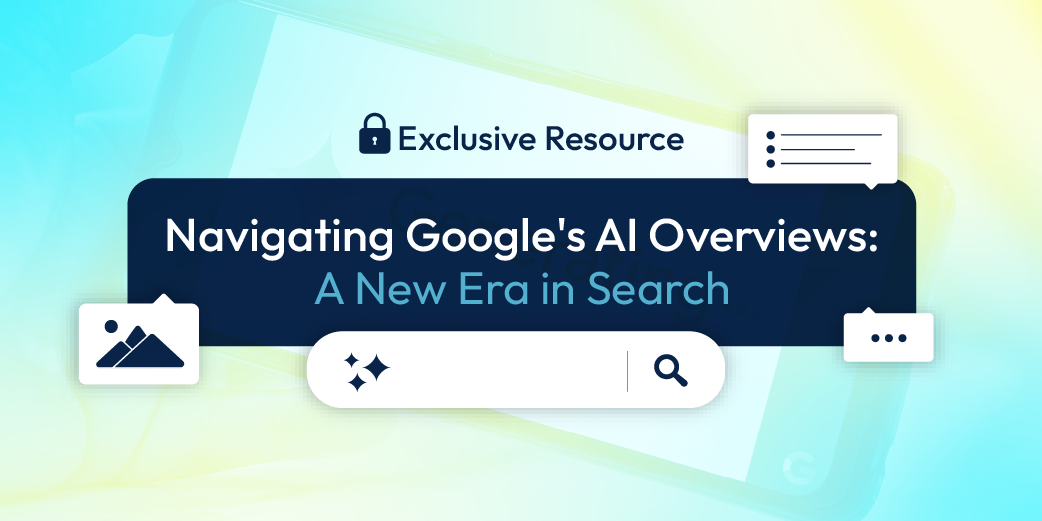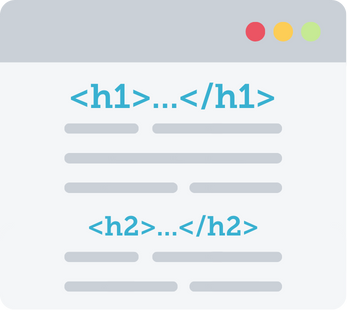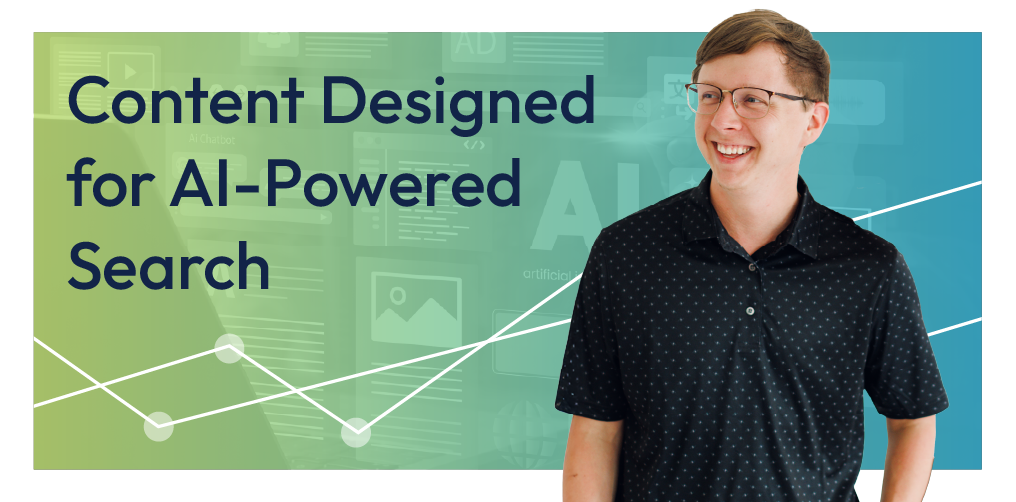How to Optimize for Google AI Overviews
Navigating Google’s AI Overviews: A New Era in Search

Google’s integration of generative AI marks a profound shift in search, bringing personalized, intent-driven experiences to users while reshaping SEO practices for businesses. By synthesizing complex queries into precise, conversational responses, Google’s AI Overviews enhance access to information while challenging brands to adapt to new standards of visibility. As AI continues to shape search results and change how people find information, it’s more important than ever for businesses to understand its impact and adapt to stay ahead.
The rise of artificial intelligence is reshaping how people interact with the internet, and nowhere is this transformation more apparent than in the evolution of Google’s search capabilities and its use of generative AI, designed to deliver highly intuitive and precise search experiences.
For organizations that rely on search visibility to drive growth, these advancements present both exciting opportunities and new challenges. As AI takes a more active role in interpreting user intent and shaping search results, understanding its impact is becoming a priority for those looking to stay ahead in a competitive digital environment. With change accelerating rapidly, businesses must embrace this moment as an opportunity to adapt, innovate, and build stronger connections with their audiences.
Understanding Google AI
Artificial intelligence (AI), whether you’ve realized it or not, has changed how we access and engage with information online. For decades, Google’s mission has been to “organize the world’s information and make it universally accessible and useful.” Now, with the integration of AI, that mission is evolving in unimaginable ways.
Google’s AI tools now encompass a suite of resources and technologies designed to understand, process, and respond to human questions with unprecedented accuracy and sophistication. These innovations aren’t just making using Google easier, they’re also changing how businesses connect with their audiences through search.
What is Google AI?
Google AI refers to the integration of artificial intelligence into Google’s products and services, with a focus on making search smarter and more helpful. It builds on decades of advancements in machine learning, natural language processing (NLP), and data analysis to make the search experience more intuitive. In simple terms, it enables search engines to “think” more like humans. Generative AI is now able to grasp context, intent, and the subtle meanings behind words that older search systems might have missed.
This technology powers features like Google’s Knowledge Graph, which connects facts and ideas, and BERT (Bidirectional Encoder Representations from Transformers), a system that helps search engines interpret how words in a query relate to each other. Recently, Google has introduced generative AI, which goes beyond simply finding information. These advanced systems can create natural, human-like responses to more complex questions, taking the search experience to an entirely new level.
For users, this means fewer searches to find what they need and more accurate, actionable results. For businesses, it highlights the growing importance of creating content that aligns with these advanced systems by providing clear, relevant answers that match how AI evaluates and delivers information.
From Code Red to Generative AI: Google’s Strategic Response
If all of this sounds completely new to you, you’re not alone. The rise of AI-powered tools like OpenAI’s ChatGPT in 2022 caught many people, and even industry giants, off guard. ChatGPT’s ability to generate detailed, conversational responses sparked widespread interest and led to what insiders referred to as a “Code Red” moment for Google.
For the first time in years, the company’s dominance in search was being questioned. In response, Google doubled down on its AI initiatives, embedding generative AI technologies into its search functionality to stay ahead and continue leading the way in organizing and delivering information.
By advancing generative AI and introducing models like Gemini, Google’s own language-learning model similar to ChatGPT, the company is reaffirming its commitment to leading the evolution of artificial intelligence. These systems represent a major leap from traditional link-based search algorithms, synthesizing information from multiple sources into clear, conversational answers.
For businesses, this fast-paced change means adjusting to a search experience that focuses on providing direct answers, understanding user intent, and interpreting content with greater sophistication. These shifts are reshaping how people discover and interact with information online, creating new opportunities for businesses to connect with their audiences.
How Google’s Generative AI Powers Search
One of the most significant advancements in generative AI is its ability to create rich, conversational responses. For example, instead of simply listing the top-ranking pages for “best marketing strategies for small businesses,” Google’s AI overviews might generate a detailed summary of effective strategies, combining insights from multiple credible sources.
However, this technology is not without its challenges. Generative AI occasionally produces “hallucinations”, plausible-sounding but inaccurate information. To mitigate this, Google has emphasized transparency by providing source citations for its AI-generated responses, encouraging users to explore the original content for verification.
For businesses, understanding how this system works is key to thriving in an AI-enhanced search environment. Content must not only answer questions clearly and concisely but also align with how AI synthesizes and presents information. In other words, content is still king.

However, gone are the days when churning out content for content’s sake was enough. Building topical authority, optimizing for featured snippets, and maintaining technical SEO best practices are now indispensable strategies for ensuring visibility.
Businesses that understand and embrace these changes have the opportunity to establish stronger, more meaningful connections with their audiences. The key is adapting quickly, staying informed, and leveraging these advancements to their full potential.
How Google AI Affects Search and SEO
The integration of AI into Google’s search functionality is transforming how users interact with the internet. By interpreting intent with greater precision and delivering more intuitive results, Google AI has elevated the search experience while introducing significant shifts for businesses striving to maintain visibility.
For marketers, these changes necessitate a deeper understanding of user intent, evolving search result formats, and the challenges AI presents. Below, we explore how AI enhances Google’s ability to align with search intent, reshapes SEO strategies, and introduces new dynamics like zero-click searches and the risks of AI-generated inaccuracies.
Aligning Google AI with Search Intent
Search intent, the reason behind what a user is searching for, has always been at the heart of effective SEO. With Google AI, this concept is taken to a whole new level. Google’s advanced tools don’t just analyze the words in a query; they work to understand the “why” behind it. What is the user really looking for? What problem are they trying to solve?
Traditional search algorithms, which relied heavily on matching keywords, often struggled with vague or conversational questions. For example, a query like "best ways to boost sales" could produce generic results that didn’t quite hit the mark. Enter Google AI. These systems can break down complex questions and interpret their deeper meaning. This allows Google to deliver answers that are far more tailored, relevant, and helpful; getting users closer to the information they need with less effort.
For businesses, this shift makes one thing clear: success hinges on creating content that is conversational in nature and answers questions with both depth and authority.
AI Risks and Challenges
As advanced as Google AI has become, it is not without challenges. One major risk is the potential for “hallucinations,” where AI generates plausible but incorrect information. For example, an AI summary might misstate a product feature or misattribute a claim, potentially harming trust in your brand.
Bias is another concern. AI learns from existing data, which means it can unintentionally amplify societal biases or exclude diverse perspectives. For instance, certain demographics or viewpoints might be underrepresented in results. Businesses can combat this by creating inclusive, well-rounded content that appeals to a broad audience while reflecting varied experiences.
Lastly, there’s the question of accountability. When AI makes errors, who’s responsible?
Brands have limited control over how AI interprets and synthesizes their content, even if that content is accurate and well-crafted. This unpredictability makes it essential for businesses to stay vigilant, regularly monitoring
how their brand is represented in AI-driven summaries and being prepared to pivot quickly if their content is misrepresented or misunderstood.
The Rise of Zero-Click Searches

One of the most notable trends driven by AI Overviews is the increase in zero-click searches, or search sessions where users find answers directly on the search results page without clicking through to a website. Zero-click searches are nothing new, but AI Overviews are amplifying their impact. By delivering highly detailed, AI-generated answers directly in search results, Google reduces the need for users to visit external websites for information.
While zero-click searches enhance user convenience, they pose a challenge for businesses reliant on organic traffic. For instance, a query like “how to fix a leaky faucet” might be fully answered on the search page, leaving no need to click through.
To stay visible, businesses must adapt. Optimizing for featured snippets means structuring content to answer questions clearly. Using schema markup can enhance rich results, like “Call Now” buttons in local searches. Crafting concise, authoritative content increases the chances of being featured in AI summaries.
And although
zero-click searches reduce traditional traffic, they also present opportunities to establish authority. If AI consistently cites a business’s content, it reinforces the brand’s credibility, encouraging users to seek it out directly for further information.
Optimizing for Google AI Overviews
By now, it’s no secret that this technology has fundamentally altered the rules of SEO, requiring marketers to rethink their strategies to stay competitive. AI-generated overviews prioritize relevance, authority, and user-focused content, creating creating a dynamic where success depends on aligning with both user intent and AI evaluation criteria.
SEO Best Practices in the AI Era
Focus on Featured Snippets
Featured snippets were once the gold standard of search visibility, and they continue to play an important role, albeit in a different way. These concise answers, prominently displayed towards the top of search results, are now often incorporated into AI-generated overviews.
To secure these valuable positions, use headers, bullet points, and short, focused paragraphs to make your content easy to read for both users and AI systems. Prioritize clarity and organization, and you’ll increase your chances of being featured in this highly visible search real estate.
For example, instead of a broad topic like “Social Media Marketing,” create in-depth guides such as “How to Use Instagram Stories to Engage Your Audience.” Additionally,
targeting long-tail keywords, specific phrases with lower competition, can increase your chances of ranking for niche searches.

Title Tag Optimization
Metadata, particularly title tags, plays a significant role in AI-driven search. Craft titles that are concise yet descriptive, incorporating target keywords in a natural, user-friendly way. For example, “5 Tips to Improve Website Speed” is more effective than “Website Speed Guide” because it signals value and relevance to both users and AI.
AI systems also favor titles that directly match search intent, so aligning your titles with common keywords and queries can boost visibility in overviews.
Technical SEO
Technical SEO remains as important as ever in the AI era. Your site needs to be fully crawlable, on both desktop and mobile, with a clear structure and no technical barriers that might confuse search engines.
Page speed is equally important; slow-loading pages are at risk of being deprioritized by Google AI. Tools like Google Search Console can help identify crawl issues, while Core Web Vitals reports offer insights for optimizing site performance.
Structured data is another key component. Implementing schema markup allows AI systems to better interpret and categorize your content, increasing the likelihood of appearing in AI-generated summaries, rich results, or featured snippets.
Where are your social media strengths, gaps, and opportunities?
We can tell you, and it’s free.
Content Strategy in the AI Age
Invest in Content Quality, Not Quantity
AI rewards content that delivers value over sheer volume. Instead of publishing frequent but shallow posts, focus on creating fewer, higher-quality pieces that address specific user needs.
Quality content is more likely to appear in AI-generated overviews, driving visibility and trust.
Build Topical Authority
Establishing topical authority is key to standing out in AI-enhanced search. This involves creating a library of interconnected content that covers a subject comprehensively.
Instead of sticking to rigid themes, focus on building depth by addressing every angle of a topic. For example, a digital marketing agency might produce beginner SEO guides, advanced strategies, and case studies, creating a resource that speaks to a variety of audience needs.
When your site becomes a go-to resource on a specific topic, AI systems are more likely to pull your content into overviews, boosting your credibility and visibility.
Make Every Click Count
With the rise of zero-click searches, businesses must find ways to make organic traffic work harder. Encourage deeper engagement by providing clear calls to action, internal links to related content, and downloadable resources that keep users on your site longer.
Additionally, optimize for user retention by creating multimedia content, such as videos or interactive infographics, which can enhance engagement and reduce bounce rates.
Tracking and Measuring AI Presence
To optimize effectively, it’s essential to monitor your performance in AI-influenced search environments. Tools like Google Search Console, SEMrush, and Ahrefs provide valuable insights into keyword rankings, traffic trends, and featured snippet performance.
Pay close attention to metrics like:
- Click-through rates (CTR): Are users engaging with your results?
- Bounce rates: Is your content meeting user expectations?
- Time on page: Are visitors finding value in your content?
Additionally, track how your content is being used in AI overviews. While tools for directly measuring AI citations are still emerging, observing shifts in traffic patterns and rankings can indicate where adjustments are needed. Regularly auditing your content for relevance, accuracy, and alignment with AI priorities will help you stay competitive.
Preparing for What’s Next in AI and Search
This rapid evolution of AI technology is transforming how information is discovered, interpreted, and delivered. Google’s integration of generative AI into its search processes is just the beginning, and the coming years promise even greater changes. For businesses and marketers, preparing for these shifts requires more than just adapting to current trends, it demands forward-thinking strategies that prioritize agility, innovation, and resilience.
A Glimpse into the Future
As AI continues to advance, search results will likely evolve far beyond the list-based format we see today. In the future, AI-driven search engines could deliver entirely personalized experiences, tailoring results not just to the query but to the user’s preferences, behaviors, and context. Imagine searching for “best vacation destinations” and receiving a fully curated itinerary based on your travel history, budget, and favorite activities.
We may also see the rise of multi-modal search results, where text, images, and videos are seamlessly combined to deliver richer, more immersive answers. Google’s Gemini AI, which integrates multi-modal capabilities, hints at a future where users can input a photo, ask a question about it, and receive a detailed response. This could redefine the way businesses present their content, pushing for dynamic, multimedia-rich formats.
Another possibility is AI-powered task completion, where search doesn’t just provide information but also facilitates action. For example, a query like “book a table at a French restaurant near me” might lead to a reservation being made directly within the search interface. Businesses will need to adapt by ensuring their services are fully integrated with AI platforms, making them accessible at every step of the customer journey.
While these developments offer exciting possibilities, they also highlight the importance of staying agile and proactive. Businesses that anticipate these changes, or partner with a digital agency that understands how to adapt to them, while trying new content formats and engagement strategies will be best positioned to thrive.

Bottom Line
Advanced technologies like generative AI enable search engines to better understand user intent, synthesize information, and deliver results with unmatched accuracy and relevance. For businesses, this creates exciting opportunities to boost visibility and connect meaningfully with audiences, but it also introduces challenges like zero-click searches and fierce competition for AI-optimized results.
Success in this changing environment requires more than a reactive approach. Businesses must embrace proactive strategies, focus on creating high-quality, authoritative content, diversify marketing efforts, and stay ahead of AI-driven trends.
At RivalMind, we specialize in helping businesses thrive, and in this new era of AI-driven search, that commitment remains the same. From optimizing content for AI-generated overviews to enhancing your online presence, our team crafts strategies designed to keep you ahead of the curve.
Ready to future-proof your digital marketing?
Contact us today for a consultation or
request a free SEO audit to discover your next steps to success.
Frequently Asked Questions (FAQs)
How does Google AI affect small businesses?
Google AI has the potential to both help and challenge small businesses. On the positive side, AI rewards high-quality, relevant content, which gives smaller businesses an opportunity to compete with larger organizations by demonstrating authority and expertise in their niche. AI also improves search intent matching, helping small businesses reach more targeted audiences.
However, challenges like the rise of zero-click searches and increased competition for featured snippets can make it harder for smaller companies to drive organic traffic. To thrive, small businesses should focus on creating valuable, user-centric content, optimizing for local search, and diversifying their digital marketing efforts across multiple channels like email, social media, and paid ads.
Can I still rely on SEO in an AI-dominated search environment?
Absolutely. While AI has introduced new dynamics to search, SEO remains a cornerstone of digital marketing. The strategies have evolved, but the principles of creating high-quality, relevant content and maintaining technical optimization are more important than ever.
AI emphasizes intent-driven results, which means businesses must align their SEO efforts with user needs rather than simply chasing keywords. Businesses who build their topical authority, target their content for featured snippets, and prioritize user experience, can continue to see strong results from SEO, even in an AI-driven search environment.
What tools can help monitor my AI-related search performance?
Several tools can provide valuable insights into how your website performs in AI-driven search environments:
- Google Search Console: Monitor organic traffic, track featured snippets, and identify changes in click-through rates that may be influenced by AI.
- SEMrush and Ahrefs: Analyze keyword rankings, assess backlink profiles, and track visibility in SERPs, including featured results.
- Sistrix: Evaluate how often your content appears in zero-click search results or AI-generated overviews.
- Analytics Platforms: Tools like Google Analytics and Hotjar can help measure user behavior on your website, allowing you to refine content based on engagement metrics.
Looking for more organic website traffic?
Welcome to RivalMind. Our purpose is to help your business thrive. We are a digital marketing agency that offers SEO, PPC, Web Design, Social Media and Video Solutions as tools to our clients for online business development and growth.
Contact us today to get started!
Blog Contact Form
Connect with Us:





